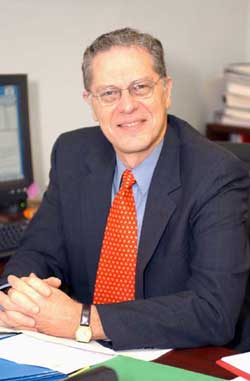- Joseph Hooton Taylor, Jr.
Infobox Scientist
name = Joseph Hooton Taylor, Jr.

imagesize = 180px
birth_date = birth date|1941|03|29|df=yes
birth_place =Philadelphia, Pennsylvania , USA
nationality =United States
field =Physics
work_institutions =Princeton University University of Massachusetts Five College Radio Astronomy Observatory
alma_mater =Haverford College Harvard University
doctoral_advisor =
doctoral_students =
known_for =
religion = Quaker
influences =
influenced =
prizes =Wolf Prize in Physics (1992)Nobel Prize in Physics (1993)
footnotes =Joseph Hooton Taylor, Jr. (born
March 29 ,1941 ) is an Americanastrophysicist andNobel Prize in Physics laureate for his discovery withRussell Alan Hulse of a "new type of pulsar, a discovery that has opened up new possibilities for the study of gravitation."Biography
Taylor was born in
Philadelphia to Joseph Hooton Taylor, Sr., and Sylvia Evans Taylor, both of whom had Quaker roots for many generations, and grew up inCinnaminson Township, New Jersey . He attended theMoorestown Friends School inMoorestown, New Jersey , where he excelled in math. [Seife, Charles. [http://www.princeton.edu/~paw/archive_old/PAW95-96/02_9596/1011feat.html "Spin Doctor: Nobel Physicist Joseph Taylor Takes the "Pulse" of Dying Stars"] , "Princeton Alumni Weekly",October 11 ,1995 . AccessedOctober 26 ,2007 . "Born in Philadelphia in 1941, he grew up on a peach farm inCinnaminson, New Jersey , that has been in his family for more than two centuries -"a plot of green," he recalls, in the industrial belt along the Delaware River north of Camden.... As a high school student at Moorestown (N.J.) Friends, Taylor excelled in mathematics, a subject he pursued at Haverford College before switching to physics."] He received a B.A. inphysics atHaverford College in 1963, and a Ph.D. inastronomy atHarvard University in 1968. After a brief research position at Harvard, Taylor went to theUniversity of Massachusetts , eventually becomingProfessor of Astronomy and Associate Director of theFive College Radio Astronomy Observatory . Taylor's thesis work was on lunar occultation measurements. About the time he completed his Ph.D.,Jocelyn Bell discovered the first radio pulsars with a telescope nearCambridge ,England .Career
Taylor immediately went to the
National Radio Astronomy Observatory 's telescopes inGreen Bank, West Virginia , and participated in the discovery of the first pulsars discovered outside Cambridge. Since then, he has worked on all aspects of pulsar astrophysics. In1974 , Hulse and Taylor discovered the firstpulsar in a binary system, namedPSR B1913+16 after its position in the sky, during a survey for pulsars at theArecibo Observatory inPuerto Rico . Although it was not understood at the time, this was also the first of what are now called "recycled" pulsars:neutron star s that have been spun-up to fast spin rates by the transfer of mass onto their surfaces from a companion star.The orbit of this binary system is slowly shrinking as it loses
energy because of emission of gravitational radiation. The rate of shrinkage can be precisely predicted from Einstein's theory, and over a thirty-year period Taylor and his colleagues have made measurements that match this prediction to much better than one percent accuracy. There are now scores of binary pulsars known, and independent measurements have confirmed Taylor's results.In 1980, he moved to
Princeton University , where he was the James S. McDonnell Distinguished University Professor in Physics, having also served for six years as Dean of Faculty. He retired in 2006.Amateur Radio
Joe Taylor first obtained his
amateur radio license as a teenager, which led him to the field of radio astronomy. Taylor is well known in the field ofamateur radio weak signal communication and was assigned thecall sign K1JT by theFCC . He wrote WSJT ("Weak Signal/Joe Taylor"), a software package and protocol suite that utilizes computer-generated messages in conjunction with radiotransceiver s to communicate over long distances with other amateur radio operators. WSJT is useful for passing short messages via non-traditional radio communications methods, such as moonbounce andmeteor scatter and other lowsignal-to-noise ratio paths. It is also useful for extremely long-distance contacts using very low power transmissions.Honours and awards
Taylor has used this first binary
pulsar to make high-precision tests ofgeneral relativity . Working with his colleagueJoel Weisberg , Taylor has used observations of this pulsar to demonstrated the existence ofgravitational radiation in the amount and with the properties first predicted byAlbert Einstein . He and Hulse shared theNobel Prize for the discovery of this object.In addition to the Nobel Prize, Taylor has been recognized with many other awards, including the first Heineman Prize of the
American Astronomical Society , theHenry Draper Medal of the National Academy of Sciences, theTomalla Foundation Prize , theMagellanic Premium , theCarty Award for the Advancement of Science , theAlbert Einstein Medal , theWolf Prize in Physics , and theKarl Schwarzschild Medal . He was among the first group of MacArthur Fellows. He has served on many boards, committees, and panels, co-chairing the Decadal Panel of that produced the report "Astronomy and Astrophysics in the New Millennium" that established theUnited States 's national priorities in astronomy and astrophysics for the period 2000-2010.ee also
*
Harold E. Taylor brother.References
External links
* [http://pupgg.princeton.edu/www/jh/research/Taylor_Joseph.htmlx Joseph Taylor, Dept. of Physics, Princeton University, Princeton, New Jersey]
* [http://www.nobel.se/physics/laureates/1993/ 1993 Nobel Physics laureates]
* [http://nobelprize.org/physics/laureates/1993/taylor-autobio.html Nobel autobiography]
Wikimedia Foundation. 2010.
